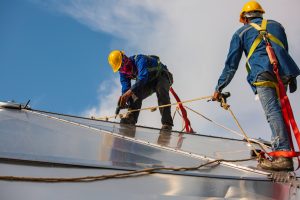Height Safety Inspections: All you Need to Know
An annual height safety inspection is essential to ensure your equipment is suitable for use and your employees are safe while working at heights.
Employing an experienced and qualified Height Safety Equipment Inspector is vital to guaranteeing this process is done correctly.
In this article, we’ll tell you everything you need to know about Height Safety Inspections, explain what the BS EN 795 Standards are, and explain what the Height Safety Equipment Inspectors here at Streval can do for you.
What is a Height Safety Inspection?
A Height Safety Inspection is a comprehensive assessment of the safety of your working conditions.
Your Height Safety Equipment Inspector will report on the viability of your equipment, the fall protection systems in place, your access points, work areas, and emergency procedures.
This all-encompassing inspection is often confused with a Fall Arrest Equipment Inspection.
Although these assessments are similar, the Fall Arrest Equipment Inspection isn’t as thorough and focuses solely on your equipment.
The equipment evaluated in the Fall Arrest Equipment Inspection includes safety harnesses, lanyards, lifelines and anchors.
What are the BS EN 795 Standards?
The BS EN 795 Standards define the technical requirements of anchor devices. There are five types of anchor devices covered in these standards, named alphabetically from A-E.
A anchorage devices are single-point anchors, such as eyebolts, anchor plates, and beam clamps.
B anchorage devices are horizontal lifeline systems.
C anchorage devices are rigid rail systems like what skyscraper window cleaners use.
D anchorage devices are designed to move, not stay fixed to a single anchorage point.
E anchorage devices are specifically designed for emergency rescues.
The BS EN 795 Standards ensure each of these systems are safe for use. To ensure your fall arrest systems are in working order, you should have them inspected professionally bi-annually, and failing to do so can result in loss of life.
What Happens During a Height Safety Inspection?
A Height Safety Inspection begins with thorough planning and preparation. Your Height Safety Equipment Inspector will familiarise themselves with your site, possible hazards, specific concerns, and relevant documentation.
The access points, fall protection systems and emergency procedures are assessed for signs of damage and improper installations.
Once your Height Safety Equipment Inspector has completed their preliminary investigation, they will test your equipment, access points, working area, and emergency procedures. This ensures a comprehensive report is written and proper action is taken to amend all identified risks and problems.
Once the inspection is complete, the findings are thoroughly documented. This includes an extensive description of the problems discovered during the inspection and possibly a collection of photographs and measurements.
Your Height Safety Equipment Inspector will talk you through their findings, describe the hazards they identified, and explain the corrective action you must take.
They may also arrange a follow-up inspection to ensure their recommendations have been followed.
How can Streval Help?
Here at Streval, we have extensive experience performing Height Safety Inspections on Mansafe fall arrest and restraint systems for companies across the UK.
We are fully certified (and work compliantly with) all relevant regulations and follow the BS EN 795 guidelines.
If you’d like Streval to conduct your Height Safety Inspection, please don’t hesitate to contact us!

